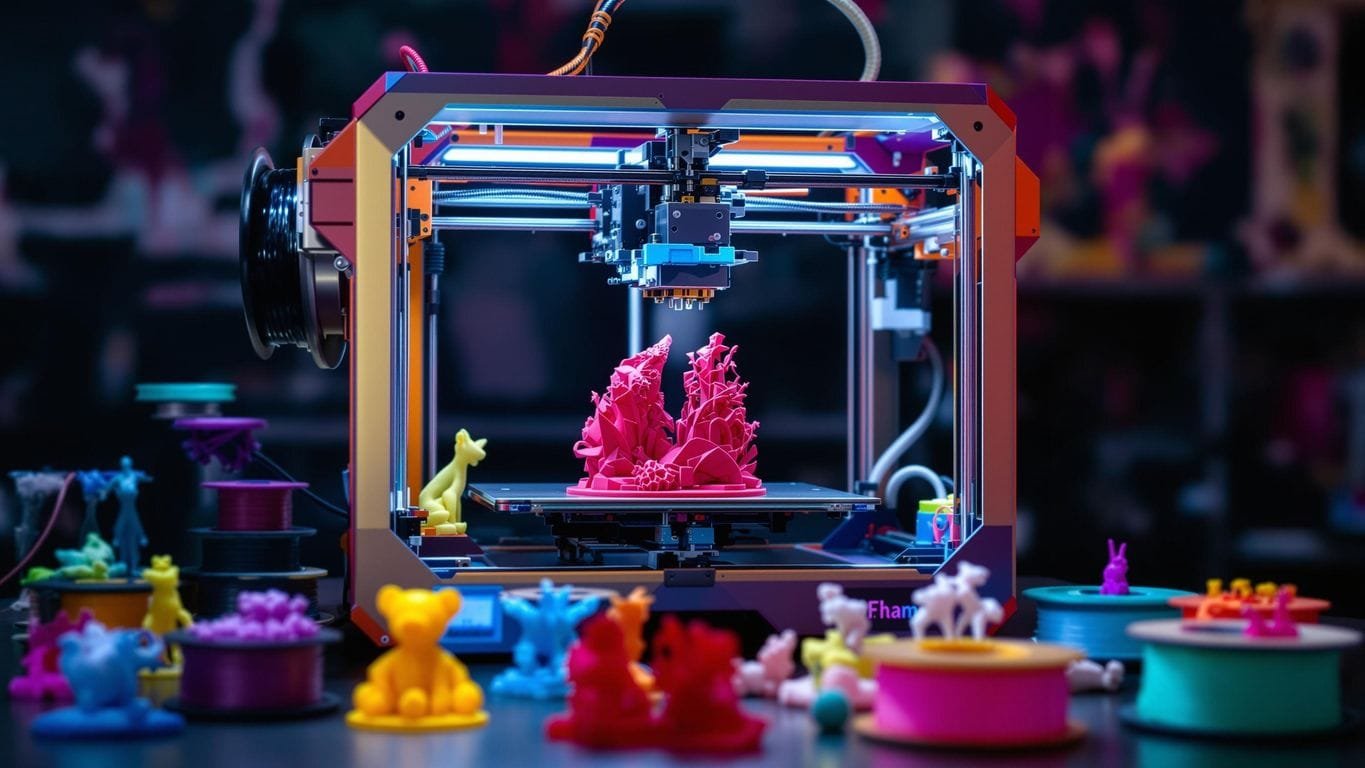

3D Printing: Create a New Side Hustle This 2025
Thinking about 3D printing as a way to earn some extra cash? It’s not just a hobby anymore—it’s a real opportunity to make a passive income. From offering services to creating content, there are tons of ways to get started. Whether you’re a tech enthusiast or just curious, there’s something for everyone in the 3D printing world. Let’s dive into some of the best ways to turn your 3D printer into a money-making machine.
Key Takeaways
- 3D printing offers diverse ways to earn passive income.
- You can start a YouTube channel focused on 3D printing.
- Renting out your 3D printer can be a smart income strategy.
- Creating and selling digital 3D designs is profitable.
- Dropshipping 3D equipment is a low-risk business model.
1. 3D Printing Services

So, you’ve got a 3D printer and you’re itching to make some money with it? Offering 3D printing services might just be your ticket. This is where you can really shine by creating unique, in-demand products. Many people and businesses are looking for custom items but don’t have the equipment or know-how to make them themselves.
Here’s how you can get started:
- Identify Your Niche: Find out what people are looking for. Are they into custom jewelry, gadgets, or maybe even home decor? Knowing your market is key. You might want to check out how others are selling physical products created through 3D printing to get some ideas.
- Set Up Shop: Create a website or use platforms like Etsy to showcase your work. Make it easy for folks to place orders and ask questions. Pricing can be tricky, so consider offering a range of options based on complexity and order size.
- Promote Your Services: Use social media and online forums to spread the word. Show off your work and let people know what you can do. You might even want to team up with local businesses or attend trade shows to network.
“The real money in offering a 3D printing service, especially if you’re a small business, is if you can differentiate yourself from merely becoming a commodity.”
By focusing on what makes you unique, you can stand out in the market. Maybe you offer faster turnaround times, or perhaps you specialize in a certain type of product. Whatever it is, make sure your customers know why they should choose you over the competition.
And remember, this isn’t just about printing stuff. It’s about building relationships with your clients and providing them with top-notch service. If you can do that, you’ll be well on your way to turning your 3D printing hobby into a profitable business.
2. YouTube Channel
Creating a YouTube channel focused on 3D printing can be a fantastic way to share your passion while generating passive income. Consistency and creativity are key to building an engaging channel that attracts viewers and subscribers.
Steps to Start Your Channel
- Define Your Niche: Focus on a specific aspect of 3D printing, like tutorials, product reviews, or showcasing unique prints.
- Plan Your Content: Develop a content calendar to ensure regular uploads. This helps keep your audience engaged and coming back for more.
- Optimize for SEO: Use relevant keywords in your video titles and descriptions to improve discoverability.
“With a well-planned approach, your 3D printing YouTube channel can become a reliable source of passive income.”
Monetization Strategies
- Ad Revenue: Once you meet the criteria for the YouTube Partner Program, you can earn from ads placed on your videos.
- Affiliate Marketing: Promote products related to 3D printing and earn a commission on sales.
- Merchandise Sales: Sell branded merchandise to your audience.
Starting a YouTube channel might seem daunting, but it offers a creative outlet and a chance to explore innovative income opportunities without the need for heavy initial investment. Remember, the journey is as rewarding as the destination, especially when you see your subscriber count grow.
3. 3D Printer Rental

Renting out your 3D printer can be a clever way to earn some extra cash. If your printer often sits idle, this option turns it into a source of passive income. The idea is simple: let others use your equipment for a fee, and you’ll make money without much effort.
How to Get Started
- Research Local Demand: Before diving in, check if there’s demand in your area. Some folks might prefer to own their printers, but many are happy to rent.
- Choose a Platform: Use rental platforms like FatLlama or Loanables to connect with potential renters. These platforms simplify the process by handling payments and contracts.
- Set Competitive Rates: Pricing can vary, but typically ranges from $25 to $40 per day. Be competitive but also ensure you’re covering your costs.
Benefits of Renting
- Minimal Effort: Once set up, the process requires little ongoing work.
- Cost Recovery: Renting helps you recoup some of the initial investment you made in your 3D printer.
- Flexibility: You can choose when to make your printer available, fitting around your schedule.
Renting out your 3D printer is like having a mini business without the headache of full-time management. It’s about smartly using what you already have.
Things to Consider
- Maintenance: Regular maintenance is crucial to ensure your printer is always in top condition for renters.
- Insurance: Check if your equipment is covered under insurance while it’s rented out.
- Terms and Conditions: Clearly outline what renters can and cannot do with your printer to avoid misunderstandings.
Renting your 3D printer might not make you rich overnight, but it’s a solid step towards building a diverse income stream. Combine this with other strategies, like starting online businesses or selling digital products, and you could create a robust financial portfolio.
4. 3D Printer Repair
Finding Your Niche in 3D Printer Repair
3D printers are amazing, but they can be tricky to maintain. With so many people jumping into 3D printing, there’s a growing need for repair services. Becoming a go-to repair expert can be your ticket to a steady income. Here’s how you can dive into this field:
- Learn the Basics: Get familiar with different 3D printer models and their common issues. Start with online resources or local workshops.
- Hands-On Practice: Tinker with old or unused printers to understand their mechanics.
- Networking: Connect with local makerspaces or online forums to share knowledge and get advice.
Offering Comprehensive Services
When you think of 3D printer repair services, consider offering a full package. Here’s what you might include:
- Routine Maintenance: Regular check-ups to prevent bigger problems.
- Part Replacement: Swapping out worn or broken parts.
- Upgrades: Helping clients enhance their printer’s capabilities.
Essential Tools and Equipment
You don’t need a huge investment to start. Here are some basic tools you might need:
- Screwdrivers and pliers
- Multimeter for electrical checks
- Spare parts like belts and nozzles
Expanding Your Skill Set
To stand out, consider learning about STL repair techniques and how to fix common file issues that can affect print quality.
“Fixing a 3D printer is like solving a puzzle. Each problem is a clue, and your job is to piece it all together.”
Marketing Your Services
Once you’re ready, it’s time to let people know about your skills. Here are some ideas:
- Create a simple website or social media page showcasing your work.
- Offer free diagnostics to attract new clients.
- Partner with local businesses or schools that use 3D printers.
By following these steps, you can turn your knack for fixing things into a thriving business. With the right skills and a bit of hustle, 3D printer repair could be your next big gig.
5. 3D Scanning Services
3D scanning is like magic for the digital world. It lets you capture the exact shape and details of an object and turn it into a digital model. This service is super handy for businesses that want to recreate expensive or out-of-production items through affordable 3D printing. You can target companies that don’t have their own 3D scanning equipment and offer them your scanning services.
- Reverse Engineering: Use 3D scanners to create digital copies of objects. This can help businesses replicate pricey or hard-to-find parts. It’s a big hit with industries that need to recreate components without the original designs.
- Customization: Offer tailored 3D scanning services for clients needing specific adjustments or modifications to existing designs.
- Preservation: Museums and collectors often need to digitize artifacts for preservation or exhibition purposes.
Offering 3D scanning can be a game-changer for your side hustle. It’s a service that not only supports industries like manufacturing and design but also opens up possibilities in art and education.
3D scanning services can be a part of a bigger Beer Money Engine strategy, where you diversify income streams by investing in tools and skills that bring continuous returns. Whether you’re scanning for reverse engineering or preservation, the demand for digital replicas is on the rise. As more businesses and institutions recognize the value of digital models, your expertise in 3D scanning can become a reliable source of passive income.
6. Digital 3D Designs
Creating and selling digital 3D designs is a fantastic way to make money with your 3D printer. The beauty of this venture is that you don’t need to manage physical inventory. Once you’ve designed a model, you can sell it repeatedly. This means that your initial effort can continue to generate income over time. Here’s how you can get started.
Getting Started with 3D Modeling
To create your digital designs, you’ll need some modeling software. Luckily, there are several free options like Blender, FreeCAD, and OpenSCAD that are perfect for both beginners and seasoned pros. These tools allow you to craft intricate and detailed models without a hefty price tag.
Protecting Your Designs
Once you’ve created your designs, it’s essential to protect them. Consider watermarking your images and using low-resolution previews when listing them online. Clearly state your licensing terms to prevent unauthorized use. Selling on reputable platforms that offer intellectual property protection can also help safeguard your creations.
Selling Your Designs
There are several platforms where you can sell your digital 3D designs. Popular marketplaces include CGTrader, Cults3D, and MyMiniFactory. These platforms attract a global audience, enhancing your potential for sales. Make sure to create appealing listings with high-quality renders and detailed descriptions to make your designs stand out.
Benefits of Selling Digital Designs
- Passive Income: Once your design is uploaded, it can be sold multiple times without additional effort.
- Minimal Overhead: No need for physical inventory means lower costs.
- Global Reach: Online platforms enable you to reach customers worldwide.
Selling digital 3D designs offers a unique business opportunity, allowing you to tap into the growing market for customizable and innovative products. By leveraging popular marketplaces and using free design software, you can build a successful business around your 3D modeling skills.
For those looking to explore this further, check out our insights on creating and selling digital files for 3D printing. This could be your gateway to a lucrative income stream without the hassle of physical product management.
7. Online 3D Printing Course

Creating an online 3D printing course is a fantastic way to share your skills while earning a passive income. If you’re passionate about 3D printing and enjoy teaching, this could be your ideal side hustle. Online courses have the potential to reach a global audience, which means you can teach people from all over the world right from your home.
Benefits of Creating an Online Course
- Passive Income: Once your course is up, it can keep earning money with little ongoing effort.
- Flexibility: You can create content at your own pace and update it whenever necessary.
- Scalability: Unlike in-person workshops, online courses can accommodate unlimited students.
Teaching online allows you to reach more people than you ever could in a traditional classroom setting, and it gives you the freedom to design your own curriculum.
What to Include in Your Course
When designing your course, think about what learners need. Here are some ideas:
- Basics of 3D Printing: Cover the fundamentals for beginners, including how to set up a 3D printer and basic troubleshooting.
- Advanced Techniques: Dive into more complex topics like 3D modeling or using different materials.
- Business Aspects: Consider a module on how to start a profitable 3D printing business to attract entrepreneurs.
Tools and Platforms
To create a course, you’ll need a few tools:
- Video Recording Software: Screen recording tools like OBS Studio or Camtasia can help you create professional-looking videos.
- Editing Tools: Use software like Adobe Premiere Pro or iMovie to polish your content.
- Learning Platforms: Platforms like PrintLab or Udemy can host your course and handle sales.
Marketing Your Course
Once your course is live, marketing is key:
- Social Media: Share snippets and tips on platforms like Instagram or LinkedIn.
- Email Newsletters: Build an email list to keep potential students informed about your course updates.
- Collaborations: Partner with influencers or other educators in the 3D printing community.
Creating an online course requires effort upfront, but it can pay off by establishing you as an expert in the field while generating income. Whether you focus on the technical side or the business angle, there’s a growing audience eager to learn about 3D printing.
8. 3D Print Farm

Running a 3D print farm is like having your own mini factory at home. Imagine managing a fleet of 3D printers working tirelessly to churn out products for various clients. This setup allows you to handle larger orders and increase your earnings significantly. Instead of focusing on one-off projects, you can take on bulk orders, producing everything from prototypes to small-batch products.
Key Benefits of a 3D Print Farm
- Scalability: With multiple printers, you can scale up production to meet high demand, making it ideal for businesses needing consistent supply.
- Diverse Offerings: Offer a wider variety of services, from producing intricate designs to simple, functional items.
- Reduced Lead Times: Faster production means quicker delivery to clients, enhancing customer satisfaction.
To get started, you’ll need to invest in several 3D printers and set up an efficient workflow. Software for job scheduling and printer management is crucial to keep everything running smoothly. This setup can be demanding initially, but the potential for revenue growth is substantial.
Running a 3D print farm isn’t just about printing more; it’s about creating a streamlined process that maximizes output and minimizes downtime. It’s a balancing act of technology and management, turning your passion into a profitable venture.
Incorporating a 3D print farm into your business model is a smart move if you’re looking to expand your reach and serve larger markets. As you grow, consider exploring opportunities to earn passive income through AI-powered digital product sales, which can complement your 3D printing business. This synergy not only boosts your income but also diversifies your business offerings, making you more resilient to market changes.
9. Marketplace Business Model
In the world of 3D printing, marketplaces are like bustling bazaars where designers and creators showcase their unique models. These platforms offer a way to sell your 3D designs without the hassle of setting up your own online store. This model is all about reaching a wide audience with minimal overhead.
Here’s a quick look at some popular marketplaces you might consider:
- MyMiniFactory: Known for its community-driven approach, it ensures all models are 3D printable and tested. You keep a significant portion of your sales, making it a favorite among designers.
- CGTrader: This platform not only allows you to sell your designs but also offers freelance opportunities. It’s a versatile space for anyone in the 3D model business.
- Shapeways: More than just a marketplace, Shapeways provides printing services. You can sell your models as physical products, and they handle the printing and shipping.
“Selling on these platforms can be a game-changer. You focus on creativity while the marketplace handles the logistics.”
Steps to Success
- Choose the Right Platform: Consider the type of products you have and match them with the right marketplace. Some platforms cater more to digital files, while others focus on physical products.
- Optimize Your Listings: Use high-quality images and detailed descriptions. Keywords are crucial here; they help your products show up in searches.
- Understand Pricing Structures: Each platform has its own fees and commission structures. Make sure you know how much you’re actually earning per sale.
Incorporating a profitable online business strategy can further enhance your marketplace success. By understanding the nuances of each platform, you can maximize your reach and income potential. Whether you’re selling digital designs or physical products, the marketplace business model offers a flexible and scalable way to generate passive income.
10. Dropshipping 3D Equipment
Dropshipping is a popular way to start a business without the hassle of holding inventory. It’s perfect for those interested in the 3D printing world but not keen on managing stock. This model is all about selling products without physically handling them. When a customer places an order in your online store, the supplier ships the product directly to the customer. This method cuts down on overhead costs and inventory risks.
Here’s how you can dive into dropshipping 3D equipment:
- Find Reliable Suppliers: Look for suppliers with a good reputation, quality products, and efficient shipping practices. Platforms like AliExpress and Oberlo can be useful in finding suitable suppliers for 3D printing products.
- Set Up an Online Store: Use e-commerce platforms like Shopify or WooCommerce. These platforms integrate well with dropshipping apps and allow you to create a professional-looking store, manage orders, and handle payments.
- Market Your Store: Use SEO, pay-per-click advertising, and social media marketing to drive traffic. Offering promotions and discounts can help convert visitors into buyers.
- Customer Service: Maintain clear communication with your suppliers and customers. Provide timely updates and ensure your suppliers meet their shipping commitments.
Dropshipping allows you to sell 3D printers, parts, and materials without the need for significant upfront investment. It’s a great way to enter the market and start earning with minimal risk.
By focusing on these steps, you can successfully run a dropshipping business in the 3D printing niche. It’s a straightforward way to tap into the growing demand for 3D printing equipment without the stress of inventory management. Consider exploring SUNLU’s range of 3D printing products for a variety of options to offer your customers.
If you’re looking to dive into the world of 3D equipment dropshipping, now is the perfect time to start! This business model allows you to sell high-demand products without the hassle of inventory. Visit our website to learn more about how you can kickstart your dropshipping journey today!
Conclusion
So, there you have it. 3D printing isn’t just a hobby; it’s a legit way to make some extra cash or even start a full-blown business. Whether you’re printing and selling unique items, creating content, or renting out your printer, the opportunities are pretty endless. Sure, it takes some effort and creativity, but the potential is there. Just remember, the key is to find what works for you and stick with it. Who knows? You might just turn your 3D printer into a money-making machine. So, why not give it a shot? You might surprise yourself with what you can achieve.
👉 Join Our Community for More Insights!
Subscribe to The Millionaire Playbook for:
- Weekly strategies to grow income streams.
- Proven tools and templates to fast-track success.
- Exclusive guides to launch your Fastlane business.
Frequently Asked Questions
What are 3D printing services?
3D printing services involve creating objects using a 3D printer and selling them to customers who need custom or unique items.
How can I make money with a YouTube channel about 3D printing?
You can earn money by making videos on 3D printing, like tutorials or reviews, and earning from ads and sponsorships.
What is a 3D printer rental?
A 3D printer rental means letting others use your 3D printer for a fee when you’re not using it, turning it into a source of income.
How do I start a 3D printer repair business?
You can offer repair services for 3D printers by learning how to fix them and advertising your skills to those who need help.
What are digital 3D designs?
Digital 3D designs are files that people can download and print on their own 3D printers, and you can sell these files online.
How does dropshipping work for 3D printing equipment?
Drop shipping involves selling 3D printers and parts without holding stock. When you sell something, the supplier sends it directly to the buyer.








